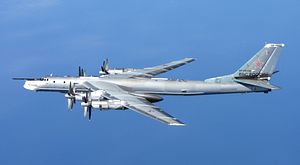Russian nuclear-capable Tupolev Tu-95MS strategic bombers, accompanied by Su-35S fighter jets and an A-50 airborne early warning aircraft, have carried out a patrol in close vicinity to the Korean Peninsula prompting the Republic of Korea Air Force (ROKAF) and Japan Air Self-Defense Force (JASDF) to scramble their fighter jets on August 24.
The bomber patrol coincided with a joint South Korea-U.S. military exercise, Ulchi Freedom Guardian 2017, which began on August 21 and will continue through August 31. Russia has publicly expressed concerns over the wargames. The bomber mission is seen as an attempt to signal Russian displeasure with both South Korea and the United States.
“The U.S. and South Korea holding yet more large-scale military and naval exercises does not help reduce tensions on the Korean peninsula,” a spokeswoman for the Russian Ministry of Foreign Affairs said on the same day the bomber patrol was conducted. “We urge all sides to exercise maximum caution. Given the arms build-up in the region, any rash move or even an unintended incident could spark a military conflict.”
The Russian bombers and their escort flew over international waters in the Pacific Ocean, the Sea of Japan, the Yellow Sea, and the East China Sea. According to South Korean government officials the Russian aircraft also briefly entered South Korea’s air defense identification zone (KADIZ).(Russia does not recognize air defense identification zones of neighboring countries.)
“As the Russian aircraft entered the KADIZ in formation yesterday morning, a squadron of our Air Force jets made an emergency sorties,” a South Korean official told Yonhap news agency. The Russian bombers, however, did not enter South Korean airspace. Japan also dispatched a number of fighter jets to escort the aircraft.
“The Tu-95MS strategic missile carriers of the Aerospace Forces carried out scheduled flights over the neutral waters of the Pacific Ocean, the Sea of Japan, Yellow and the East China Seas,” the Russian Ministry of Defense said in a statement. “Along the route long-range aircraft were accompanied by Su-35S fighters of the Eastern Military District, as well as by the A-50 airborne early warning and control aircraft of the Military Transport Aviation.”
“At certain stages of the flight, Russian strategic missile carriers were accompanied by aircraft of the Air Force of the Republic of Korea and Japan Air Self-Defense Force,” the ministry added. The Russian bombers reportedly also carried out refueling operations in mid-air.
The nuclear-capable Tupolev Tu-95MS is a four-engine, long-range, turboprop, strategic bomber that can be armed with a wide range of weapons including stand-off cruise missiles. It is an improved variant of the older Tu-95 operated by the Soviet Air Force and used to patrol the Japan-Hawaii-Guam triangle during the Cold War.
Russia is currently upgrading its Tu-95MS force and is expected to field a fleet of up to 20 retrofitted aircraft. “The upgraded aircraft, along with the Tu-22M3 long-range bomber, will form the core of a new Russian heavy bomber division in Russia’s Far East to conducts patrol Pacific Ocean inside the Japan-Hawaii-Guam triangle,” I explained earlier this month.































